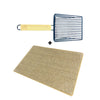If you’re Dwight Schrute from The Office, there might be a black and white answer to this question. However, there are as many bedding options as small animals to use them, and it’s not always obvious which is the best choice for your furry friend without some research.
We’ve burrowed deep into the available information, with safety as the top priority when outfitting an enclosure for a small animal, so you can understand what’s best for your guinea pig. Keep in mind these are high level findings for each type of small animal. If you’re between options, there is a ton of available research to really dig into the nitty gritty!
For guinea pigs–also called floofs–the right bedding protects their habitat, absorbs excess moisture, keeps them healthy, and provides cleanliness and comfort. Your guinea pig doesn’t want a soggy bottom any more than you do! Additionally, the wrong bedding can irritate your little one’s feet, sensitive sniffers, and other organs and systems. No bueno!
|
Option |
Pros |
Cons |
|
Wood* (including Aspen and Douglas Fir |
· Safe · Sustainable · Low dust · Great odor control |
· Some varieties are sharp or spiky · Some types of wood contain phenols |
|
Paper |
· Soft and comfortable · Widely available · Absorbent · Sustainable |
· Can contain inks, dyes, or other harmful chemicals |
|
Hemp |
· Excellent for tunneling/burrowing · Absorbent · Sustainable · Low dust |
· Can be difficult to find in stores as it’s a seasonal crop · Expensive |
|
Hay |
· Allows chewing if soft · Encourages lots of natural behaviors, including eating, foraging, and playing |
· Sharp hay can harm small animals |
|
Cloth Bedding (cotton) |
· Cozy and warm · Reusable and easy to clean |
· It’s not good for burrowing · Solid waste must be removed by hand
|
|
Bedding to Avoid |
· Anything dusty, which irritates a guinea pig’s respiratory system · Cedar, which has phenols and other toxins · Scented wood shavings, which can stress a guinea pig’s respiratory tract and ingestion can cause liver or kidney disease · Synthetic bedding like fleece, which lacks moisture absorption and does not control odors; it also must be washed frequently. ·Corncob, which molds easily when wet and can cause intestinal blockages if ingested · Cat-specific litter, particularly any with tiny pellets or heavy scents, which can irritate your small animal or could be eaten and cause blockages · Wire or mesh flooring in your enclosure |
|
*Ensure any wood bedding is phenol-free. If phenols are present, they can irritate the skin and respiratory system of your small pet and cause issues for humans, too. Wood that is kiln-dried should be phenol free.
Of course, just like humans, your small animals have innate preferences. Even if you’ve done your homework and chosen what you believe is the perfect bedding for your pet, they might have other ideas. Your furry friend will continue to show its personality, and you can keep trying until you find the best option for your little pal!
How much bedding do you need?
Below are Catalyst’s recommendations for the amount of bedding each type of small animal needs. Of course, use your own judgment as you get to know your pet’s preferences!
|
Small Animal |
Gerbil or Hamster |
Chinchilla or Ferrett |
Guinea Pig |
Rabbit |
Rat or Mouse |
|
Habitat Size |
23” x 19” |
25” x 25” |
48” x 24” |
54” x 27” |
20” x 14” |
|
Bedding Depth |
4” – 6” |
2” – 3” |
2” – 3” |
2” – 3” |
2” – 3” |
|
Amount Needed |
43L |
35L |
57L |
72L |
20L |














